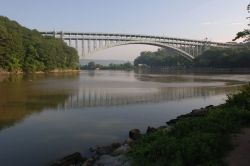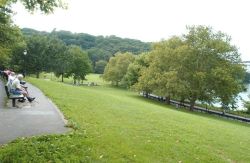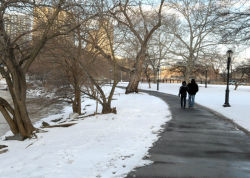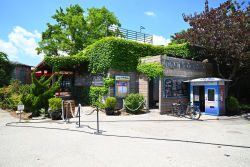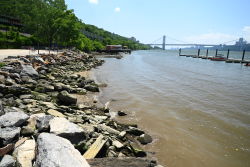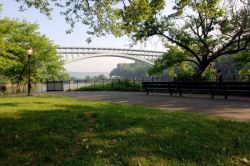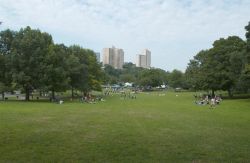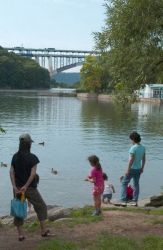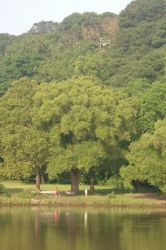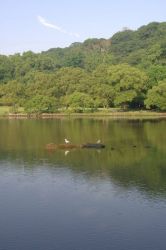Inwood Hill Park
The Daily Plant : Monday, January 22, 2007
Reunited, And It Feels So Good (Part II)
Previously in the January 18th edition of The Daily Plant:
The outlook seemed bleak. The hawk appeared to have a neurological disorder. Tests concluded that it had a dangerously low red blood cell count, which translated into anemia. The future of the Inwood couple hung in the balance.
And now, the conclusion of our tale about the Red-tails:
Bobby Horvath gave the hawk iron supplements and antibiotics. He had to force feed it because the bird simply did not eat on its own. After a few days of a high calorie liquid diet containing lactated ringers, the hawk started showing signs of improvement, but it was not out of the woods yet. The next step for the hawk was to demonstrate the ability to fly normally. Sometimes, sick or injured raptors never fully recover to the point where they are releasable into the wild and must live out the rest of their lives in captivity. After a few more days of the dietetic regimen, the hawk would be placed in a flight cage that is specially designed to allow room for practice flights. Only time would tell the outcome.
At Inwood, the Rangers kept their fingers crossed. The male hawk was observed flying around the park by itself. A bird never looked so lonely. Almost as if word had spread in the classifieds about the possible real estate vacancy at Inwood, a pair of adult Red-tails was seen flying into the park to check out the property. Though this is part of the natural process of top predators living in the wild, it was hard not to sympathize with the resident male. It would be akin to Pale Male losing his mate (which has happened before), but also getting pushed out of his well-known territory by other Red-tails. At one point, the intruding pair was flying with Inwood’s resident male, making aggressive aerial displays toward the outnumbered hawk. All the signs were pointing towards an impending eviction.
Meanwhile, back at the rehabilitation ranch, the female hawk was about to undertake her most important test. She was placed in the flight cage and began flapping her wings back and forth vigorously. Though determination is a human characteristic, it seemed as if this bird was determined to fly again – as if she wanted to see her mate again. It happened! The hawk flew to the end of the cage and back with noticeable energy. After continual observation of the bird’s flying capability, Bobby Horvath felt confident that the hawk could be released back into the wild where it came from. He placed a federal identification band on one of her legs so if need be, the hawk could be identified in the future.
The final chapter in this story would be releasing the hawk back at Inwood, but one last question remained to be answered- would her mate, if he was even there, take her back after all this time?
On December 14, 2006, the female hawk was turned over to Inwood Rangers Yekaterina Gluzberg and Jonathan Wells. They took the hawk into the woods and let her go free. She soared high on a four and a half-foot wingspan. But where was her mate? Did the other two Red-tails chase him away for good? After all the trials and tribulations of the past two weeks, it would seem tragic to have come this far only to fall short of the final hurdle of reuniting the two birds. Days went by, but only the female was seen in the park. Then days turned into weeks. The Rangers started to lose hope.
But then, on the morning of January 5, 2007, more than one month from the day the female was first observed on the forest floor, both Red-tailed hawks were seen perched next to each other on a tree. It was the happy ending we were all hoping for. From that day forward, the two hawks have been inseparable- even more so than before.
We can’t possibly know if the two hawks truly love each other. It’s easy to compare them to two people in love who were separated by circumstance only to be reunited and love each other even more. After all, that does happen in real life, not just in the movies. But what we do know is that the reunion of the Inwood Red-tails would not have been possible if it wasn’t for all the people involved in this story. The helpful park patron who first saw the female hawk. The wildlife rehabilitator who saved the hawk from almost certain death. And the Urban Park Rangers who faithfully assist animals throughout this great city, day in and day out.
Written by Howard Kreft, with Rob Mastrianni
QUOTATION FOR THE DAY
“One of the lessons of history is that nothing is often a good thing to do
and always a clever thing to say.”
Will Durant
(1885 – 1981)
Check out your park's Vital Signs
Clean & Safe
Green & Resilient
Empowered & Engaged Users
Share your feedback or learn more about how this park is part of a
Vital Park System

Know Before You Go


